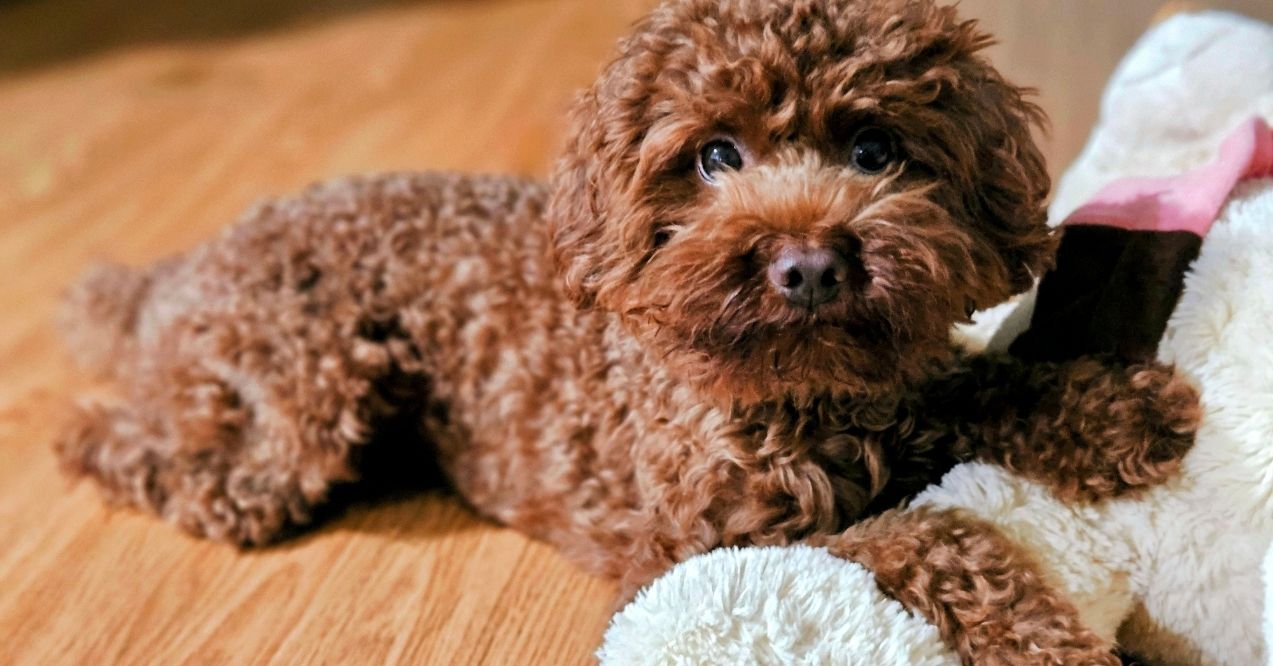Toy Poodle Behavior Problems and How to Respond
Toy poodles charm their way into our hearts with their intelligence, loyalty, and elegant prancing. Yet even these pocket-sized companions come with behavioral quirks that can puzzle or frustrate their owners.
These behaviors often reflect the breed’s working dog heritage and deep attachment to their humans. This guide covers the most common behavioral challenges and provides actionable solutions tailored to your toy poodle’s unique needs. For a deeper dive into this breed’s characteristics, check out toy poodle breed information to better understand your furry friend.
Toy Poodle Behavior Basics
Toy poodles pack big personalities into small bodies. Originally bred down from standard poodles who retrieved waterfowl, these miniature companions retained their ancestors’ sharp minds and alert nature. Their intelligence ranks among the highest in all dog breeds, which means they need constant mental engagement to stay happy.
This breed’s temperament blends sensitivity with confidence. They form intense bonds with their families while maintaining a watchful eye on their surroundings. Their portable size made them favored companions of nobility, reinforcing their preference for close human contact. These historical roles shape modern toy poodle behavior problems – from excessive barking to separation distress.
Why Breed Traits Matter
Toy poodles possess heightened alertness that once helped larger poodles spot game in water. Today, this translates to barking at unfamiliar sounds or movements. Their emotional sensitivity means they pick up on household tensions and may react with anxiety or protective behaviors. The breed’s deep attachment to humans creates velcro dog tendencies – are toy poodles velcro dogs? Absolutely, and this trait drives many behavioral challenges owners face daily.
How Age Affects Behavior
Behavioral patterns shift dramatically across a toy poodle’s lifespan. Puppies between 3-6 months focus their energy on exploration through chewing and playful nipping. Adult toy poodles (1-7 years) may develop territorial barking or separation anxiety if not properly socialized. Senior dogs over 8 years often increase vocalizations due to cognitive changes or hearing loss. Knowing these age-related patterns helps owners adjust their responses appropriately.
Most Common Toy Poodle Behavior Problems

Every toy poodle owner eventually faces at least one challenging behavior. These issues rarely appear overnight – they develop gradually through repeated patterns and reinforcement. The following behaviors top the list of owner concerns, each requiring specific management strategies.
Some problems overlap or trigger others. A bored toy poodle might start with excessive barking, progress to destructive chewing, then develop separation anxiety when owners leave to escape the chaos. Addressing root causes rather than symptoms creates lasting behavioral improvements. Let’s examine each common issue and explore targeted solutions.
Excessive Barking
Does toy poodle bark a lot? Yes, and there’s good reason. Their alert nature combined with keen hearing makes them natural watchdogs. Toy poodles bark to announce visitors, express excitement, seek attention, or communicate anxiety. Indoor barking often increases during mail delivery times, when neighbors pass by, or during household activities.
Solutions focus on teaching alternative behaviors:
- Reward quiet moments with treats or praise
- Teach a “quiet” command using positive reinforcement
- Provide puzzle toys during typical barking triggers
- Move your poodle away from windows if visual stimuli cause barking
- Create white noise to mask outside sounds
Separation Anxiety
Toy poodles form powerful attachments that can spiral into distress when left alone. Signs include destructive behavior, excessive barking, house soiling, or escape attempts. Their clingy nature – yes, are toy poodles clingy by nature – makes this one of the most challenging behaviors to modify.
Gradual desensitization works best. Start with 30-second departures, slowly extending absence periods. Leave special toys or frozen treat puzzles that only appear during alone time. Practice “independence training” while you’re home by encouraging solo play in another room. Some toy poodles benefit from calming music or pheromone diffusers during departures.
Destructive Chewing
Chewing serves multiple purposes for toy poodles – stress relief, boredom management, and dental health. Puppies chew during teething, while adults may chew when anxious or understimulated. Common targets include furniture legs, shoes, and household items within reach.
Redirect this natural behavior toward appropriate outlets. Rotate chew toys weekly to maintain novelty. Offer various textures: rubber toys, rope toys, and safe natural chews. When catching inappropriate chewing, calmly redirect to an approved toy and praise enthusiastically when they switch. Keep tempting items out of reach during the training phase.
Jumping on People or Furniture
Toy poodles jump to seek attention, express excitement, or claim elevated positions. Their small size often encourages owners to pick them up, inadvertently reinforcing jumping behaviors. This habit may seem harmless but can lead to injuries or dominance issues.
Train an automatic sit response for greetings. Turn away when jumping occurs, only giving attention when all four paws touch the ground. Practice calm greetings with family members before expecting success with visitors. For furniture jumping, provide appropriate alternatives like pet stairs or designated blankets on approved furniture pieces.
Digging or Scratching Indoors
Indoor digging often surprises toy poodle owners. This behavior may manifest as scratching at carpets, pawing at blankets, or attempting to “bury” toys. Boredom typically triggers this instinct, though some toy poodles dig to create comfortable nesting spots.
Channel digging instincts productively:
- Hide treats in blankets for supervised digging games
- Provide a designated dig box filled with safe materials
- Increase daily mental stimulation through training sessions
- Ensure adequate physical exercise despite their small size
Nipping During Play
Toy poodle puppies explore through their mouths, leading to nipping during play or excitement. Adult nipping often stems from overstimulation or poor bite inhibition learned during puppyhood. While rarely aggressive, nipping can escalate without proper management. Learning why dogs bite themselves or others helps identify underlying causes.
Implement immediate consequences for nipping – stop play and withdraw attention briefly. Redirect to appropriate toys when mouth play begins. Encourage gentle mouth behaviors by rewarding soft touches with treats. Structured socialization with well-behaved dogs teaches appropriate play boundaries naturally.
Humping or Mounting
This embarrassing behavior affects both male and female toy poodles. Humping typically indicates overstimulation, stress, or insufficient outlets for energy. Medical issues may also contribute, so sudden onset warrants veterinary consultation.
Interrupt humping immediately with distraction techniques. Increase daily exercise and mental challenges to reduce excess energy. During exciting situations, redirect attention before arousal escalates. Some toy poodles benefit from calming supplements or anxiety-reducing activities like snuffle mats during triggering events.
Redirection Strategies That Work

Managing toy poodle behavior problems requires consistent redirection toward positive activities. Success comes from understanding what motivates your specific dog – food, play, or praise – then using those rewards strategically. Timing matters tremendously; redirect before unwanted behaviors become habits.
The most effective strategies engage your toy poodle’s intelligent mind while satisfying their emotional needs. These approaches work best when implemented daily, not just during problem moments. Creating enriching environments prevents many issues before they start. Consider these methods as investments in your dog’s mental health and your household harmony.
Use of Enrichment Toys
Mental stimulation through enrichment toys can dramatically reduce toy poodle behavior problems. These intelligent dogs need puzzles that challenge their problem-solving abilities:
- Treat-dispensing balls that release kibble gradually
- Puzzle feeders with sliding compartments
- Snuffle mats for scent-based foraging
- Frozen Kong toys stuffed with safe foods
- Interactive toys that respond to manipulation
Rotate toys every few days to maintain interest and challenge levels.
Creating a Calm Routine
Toy poodles thrive on predictability. Structured routines reduce anxiety-driven behaviors by providing security. Establish consistent times for meals, walks, play sessions, and rest periods. Include dedicated training time – even five minutes daily reinforces desired behaviors. Evening wind-down routines particularly help reduce nighttime restlessness. Signal transition times with specific cues, helping your poodle anticipate and prepare for schedule changes.
Behavior Journaling
Track patterns in problematic behaviors to identify triggers and successful interventions. Note the time, location, preceding events, and your dog’s response to corrections. Weekly reviews often reveal surprising patterns – perhaps barking increases on recycling days or chewing happens mainly during afternoon hours. This data guides targeted solutions and helps measure progress over time.
When Behavior Gets Out of Hand
Some toy poodle behavior problems escalate beyond normal management strategies. Knowing when issues require additional intervention protects both your dog’s wellbeing and your relationship. Persistent problems despite consistent training may indicate underlying anxiety, medical issues, or deeply ingrained patterns.
Professional guidance becomes valuable when behaviors risk injury, damage relationships, or significantly impact quality of life. Early intervention prevents minor issues from becoming severe behavioral disorders. Trust your instincts – if something feels unmanageable, seeking help demonstrates responsible ownership, not failure.
Signs of Escalating Issues
Watch for these indicators that behavior problems need immediate attention:
- Aggression toward family members or guests
- Self-injury from excessive licking or chewing
- Destructiveness causing significant property damage
- Complete inability to tolerate being alone
- Obsessive behaviors disrupting normal activities
Are toy poodles aggressive naturally? No, but unchecked anxiety or fear can manifest as aggression in any breed.
Tools for Managing Challenging Behaviors
Physical management tools provide safety while working on behavioral modifications. Crates offer secure spaces for anxious toy poodles when properly introduced. Exercise pens create boundaries without isolation. Baby gates section off problem areas while maintaining visual contact. Calming aids like compression shirts or pheromone collars may provide additional support. Background music or white noise machines help mask triggering sounds during training phases.
Conclusion
Toy poodle behavior problems reflect the breed’s intelligence, sensitivity, and deep attachment to their humans. Most challenging behaviors – from excessive barking to separation anxiety – respond well to patient, consistent management. These small dogs carry big personalities that need appropriate outlets through mental stimulation, predictable routines, and positive redirection.
Toy poodles aren’t naturally aggressive. Aggression usually stems from fear, poor socialization, or anxiety rather than breed temperament.
Yes, toy poodles tend to bark frequently due to their alert, watchdog nature and sensitivity to environmental changes.
Weird things poodles do include spinning before lying down, “talking” with grumbles, sleeping under blankets, and obsessively arranging toys.
Yes, toy poodles are notably clingy dogs who prefer constant companionship and may develop separation anxiety without proper training.
Advertisement. This site offers health, wellness, fitness and nutritional information and is designed for educational purposes only. You should not rely on this information as a substitute for, nor does it replace, professional medical advice, diagnosis, or treatment. If you have any concerns or questions about your health, you should always consult with a physician or other health-care professional. Do not disregard, avoid or delay obtaining medical or health related advice from your health-care professional because of something you may have read on this site. The use of any information provided on this site is solely at your own risk.



















